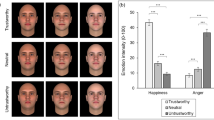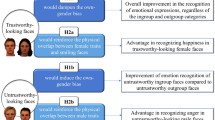Abstract
People form the first impression of trustworthiness mainly based on face when interacting with strangers. Majority of facial trustworthiness judgment tasks used in the laboratory present one face only. In real life interaction, a face usually appears in certain contexts, such as different scenes or accompanied by others. Very few studies have investigated the effect of social contexts on trustworthiness judgments. The current work examined the influence of a simultaneously presented face as a context on trustworthiness judgment of a target face. The pre-rated neutral-looking faces served the target faces that was either paired by a neutral-looking face or presented alone in Experiment 1 (N = 33). No contextual effect was found except for one condition where a male face was paired by another male face. Experiment 2 (N = 36) manipulated the trustworthiness of the context face. The results showed that the neutral-looking faces were rated more trustworthy when paired by an untrustworthy-looking face than by a neutral- or trustworthy-looking face. Experiment 3 (N = 36) replicated the results of Experiment 2 via manipulating both the trustworthiness of target and context faces. Across three experiments, we found a contrast effect of an untrustworthy context. The current findings provided new evidence for the development of theories on the effects of social context on perceived trustworthiness. A different explanation was discussed.



Similar content being viewed by others
Data availability
The datasets generated during and/or analysed during the current study are available from the corresponding author on reasonable request.
References
Aviezer, H., Bentin, S., Dudarev, V., & Hassin, R. R. (2011). The automaticity of emotional face-context integration. Emotion, 11(6), 1406–1414. https://doi.org/10.1037/a0023578
Barker, P., Dotsch, R., & Imhoff, R. (2020). Assimilation and contrast in spontaneous comparisons: Heterogeneous effects of standard extremity in facial evaluations International Review of Social Psychology, 33(1): 11, 1–17. https://doi.org/10.5334/irsp.402.
Blanchard, D. C., Hynd, A. L., Minke, K. A., Minemoto, T., & Blanchard, R. J. (2001). Human defensive behaviors to threat scenarios show parallels to fear-and anxiety-related defense patterns of non-human mammals. Neuroscience & Biobehavioral Reviews, 25(7–8), 761–770. https://doi.org/10.1016/S0149-7634(01)00056-2
Brambilla, M., Biella, M., & Freeman, J. B. (2018). The influence of visual context on the evaluation of facial trustworthiness. Journal of Experimental Social Psychology, 78, 34–42. https://doi.org/10.1016/j.jesp.2018.04.011
Bzdok, D., Langner, R., Hoffstaedter, F., Turetsky, B. I., Zilles, K., & Eickhoff, S. B. (2012). The modular neuroarchitecture of social judgments on faces. Cerebral Cortex, 22(4), 951–961. https://doi.org/10.1093/cercor/bhr166
Carragher, D. J., Lawrence, B. J., Thomas, N. A., & Nicholls, M. E. (2018). Visuospatial asymmetries do not modulate the cheerleader effect. Scientific Reports, 8(1), 1–10. https://doi.org/10.1038/s41598-018-20784-5
Carragher, D. J., Thomas, N. A., & Nicholls, M. E. (2021). The dissociable influence of social context on judgements of facial attractiveness and trustworthiness. British Journal of Psychology, 112(4), 902–933. https://doi.org/10.1111/bjop.12501
Cogan, E., Parker, S., & Zellner, D. A. (2013). Beauty beyond compare: Effects of context extremity and categorization on hedonic contrast. Journal of Experimental Psychology: Human Perception and Performance, 39(1), 16–22. https://doi.org/10.1037/a0031020
Crookes, K., Ewing, L., Gildenhuys, J.-d., Kloth, N., Hayward, W. G., Oxner, M., et al. (2015). How well do Computer-generated faces tap face expertise? PLoS One, 10(11), e0141353. https://doi.org/10.1371/journal.pone.0141353
Dalmaso, M., Castelli, L., & Galfano, G. (2020). Social modulators of gaze-mediated orienting of attention: A review. Psychonomic Bulletin & Review, 27(5), 833–855. https://doi.org/10.3758/s13423-020-01730-x
Dong, Y., Li, Y., & Sun, T. (2015). Happy faces considered trustworthy irrespective of perceiver’s mood: Challenges to the mood congruency effect. Computers & Security, 47, 85–93. https://doi.org/10.1016/j.cose.2014.04.010
Dzhelyova, M., Perrett, D. I., & Jentzsch, I. (2012). Temporal dynamics of trustworthiness perception. Brain Research, 1435, 81–90. https://doi.org/10.1016/j.brainres.2011.11.043
Eilam, D., Izhar, R., & Mort, J. (2011). Threat detection: Behavioral practices in animals and humans. Neuroscience & Biobehavioral Reviews, 35(4), 999–1006. https://doi.org/10.1016/j.neubiorev.2010.08.002
Engell, A. D., Haxby, J. V., & Todorov, A. (2007). Implicit trustworthiness decisions: Automatic coding of face properties in the human amygdala. Journal of Cognitive Neuroence, 19(9), 1508–1519. https://doi.org/10.1162/jocn.2007.19.9.1508
Faul, F., Erdfelder, E., Lang, A. G., & Buchner, A. (2007). G* power 3: A flexible statistical power analysis program for the social, behavioral, and biomedical sciences. Behavior Research Methods, 39(2), 175–191. https://doi.org/10.3758/BF03193146
Franklin, R., & Zebrowitz, L. A. (2013). Older adults’ trait impressions of faces are sensitive to subtle resemblance to emotions. Journal of Nonverbal Behavior, 37(3), 139–151. https://doi.org/10.1007/s10919-013-0150-4
Gazzaniga, M. S., & Smylie, C. S. (1983). Facial recognition and brain asymmetries: Clues to underlying mechanisms. Annals of Neurology: Official Journal of the American Neurological Association and the Child Neurology Society, 13(5), 536–540. https://doi.org/10.1002/ana.410130511
Geiselman, R. E., Haight, N. A., & Kimata, L. G. (1984). Context effects on the perceived physical attractiveness of faces. Journal of Experimental Social Psychology, 20(5), 409–424. https://doi.org/10.1016/0022-1031(84)90035-0
Gong, X., Huang, Y.-X., Wang, Y., & Luo, Y.-J. (2011). Revision of the Chinese facial affective picture system. Chinese Mental Health Journal, 25(1), 40–46. https://doi.org/10.3969/j.issn.1000-6729.2011.01.011
Hess, U., Dietrich, J., Kafetsios, K., Elkabetz, S., & Hareli, S. (2019). The bidirectional influence of emotion expressions and context: Emotion expressions, situational information and real-world knowledge combine to inform observers’ judgments of both the emotion expressions and the situation. Cognition and Emotion, 34(3), 539–552. https://doi.org/10.1080/02699931.2019.1651252
Kenrick, D. T., & Gutierres, S. E. (1980). Contrast effects and judgments of physical attractiveness: When beauty becomes a social problem. Journal of Personality and Social Psychology, 38(1), 131–140. https://doi.org/10.1037/0022-3514.38.1.131
Kenrick, D. T., Neuberg, S. L., Griskevicius, V., Becker, D. V., & Schaller, M. (2010). Goal-driven cognition and functional behavior: The fundamental motives framework. Current Directions in Psychological Science, 19(1), 63–67. https://doi.org/10.1177/0963721409359281
Keres, A., & Chartier, C. (2016). The biasing effects of visual background on perceived facial trustworthiness. Psi Chi Journal of Psychological Research, 21(3), 170–175. https://doi.org/10.24839/2164-8204.JN21.3.170
Li, Y., & Ang, Y. (2019). Facial trustworthiness judgment affected by face gender, gaze direction, and fical experessions. Advances in Psychology, 9(3), 609–617. https://doi.org/10.12677/ap.2019.93076
Li, Y., Jiao, X., Liu, Y., Tse, C.-S., & Dong, Y. (2021). Age differences in facial trustworthiness judgement based on multiple facial cues. British Journal of Psychology, 112(2), 474–492. https://doi.org/10.1111/bjop.12472
Mattavelli, G., Andrews, T. J., Asghar, A. U. R., Towler, J. R., & Young, A. W. (2012). Response of face-selective brain regions to trustworthiness and gender of faces. Neuropsychologia, 50(9), 2205–2211. https://doi.org/10.1016/j.neuropsychologia.2012.05.024
Miller, S. L., Maner, J. K., & Becker, D. V. (2010). Self-protective biases in group categorization: Threat cues shape the psychological boundary between “us” and “them”. Journal of Personality and Social Psychology, 99(1), 62–77. https://doi.org/10.1037/a0018086
Mussweiler, T. (2003). Comparison processes in social judgment: Mechanisms and consequences. Psychological Review, 110(3), 472. https://doi.org/10.1037/0033-295X.110.3.472
Ngo, N., & Isaacowitz, D. M. (2015). Use of context in emotion perception: The role of top-down control, cue type, and perceiver’s age. Emotion, 15(3), 292–302. https://doi.org/10.1037/emo0000062
Olivola, C. Y., Funk, F., & Todorov, A. (2014). Social attributions from faces bias human choices. Trends in Cognitive, 18(1), 566–570. https://doi.org/10.1016/j.tics.2014.09.007
Peng, C., Mao, Y., Pagliaro, S., Roberts, S., & Livi, S. (2020). are individuals perceived as more attractive within a group? A confirmative study of group attractiveness effect and the cheerleader effect in China. Healthcare, 8(3), 344. Multidisciplinary Digital Publishing Institute. https://doi.org/10.3390/healthcare8030344.
Said, C. P., Sebe, N., & Todorov, A. (2009). Structural resemblance to emotional expressions predicts evaluation of emotionally neutral faces. Emotion, 9(2), 260–264. https://doi.org/10.1037/a0014681
Slepian, M. L., Young, S. G., Rule, N. O., Weisbuch, M., & Ambady, N. (2012). Embodied impression formation: Social judgments and motor cues to approach and avoidance. Social Cognition, 30(2), 232–240. https://doi.org/10.1521/soco.2012.30.2.232
Sutherland, C. A. M., Oldmeadow, J. A., Santos, I. M., Towler, J., Burt, D. M., & Young, A. W. (2013). Social inferences from faces: Ambient images generate a three-dimensional model. Cognition, 127(1), 105–118. https://doi.org/10.1016/j.cognition.2012.12.001
Sutherland, C. A., Rowley, L. E., Amoaku, U. T., Daguzan, E., Kidd-Rossiter, K. A., Maceviciute, U., & Young, A. W. (2015a). Personality judgments from everyday images of faces. Frontiers in Psychology, 6, 1616. https://doi.org/10.3389/fpsyg.2015.01616
Sutherland, C. A. M., Young, A. W., Mootz, C. A., & Oldmeadow, J. A. (2015b). Face gender and stereotypicality influence facial trait evaluation: Counter-stereotypical female faces are negatively evaluated. British Journal of Psychology, 106(2), 186–208. https://doi.org/10.1111/bjop.12085
Sutherland, C. A. M., Oldmeadow, J. A., & Young, A. W. (2016). Integrating social and facial models of person perception: Converging and diverging dimensions. Cognition, 157, 257–267. https://doi.org/10.1016/j.cognition.2016.09.006
Vernon, R. J. W., Sutherland, C. A. M., Young, A. W., & Hartley, T. (2014). Modeling first impressions from highly variable facial images. PNAS, 111(32), E3353–E3361. https://doi.org/10.1073/pnas.1409860111
Walker, D., & Vul, E. (2014). Hierarchical encoding makes individuals in a group seem more attractive. Psychological Science, 25(1), 230–235. https://doi.org/10.1177/0956797613497969
Wang, J., Lin, W., Fang, X., & Mo, L. (2020). The influence of emotional visual context on the judgment of face trustworthiness. Psychology Research and Behavior Management, 13, 963–976. https://doi.org/10.2147/PRBM.S269543
Wedell, D. H., Parducci, A., & Geiselman, R. E. (1987). A formal analysis of ratings of physical attractiveness: Successive contrast and simultaneous assimilation. Journal of Experimental Social Psychology, 23(3), 230–249. https://doi.org/10.1016/0022-1031(87)90034-5
Willis, J., & Todorov, A. (2006). First impressions: Making up your mind after a 100-ms exposure to a face. Psychological Science, 17(7), 592–598. https://doi.org/10.1111/j.1467-9280.2006.01750.x
Wilson, J. P., & Rule, N. O. (2015). Facial trustworthiness predicts extreme criminal-sentencing outcomes. Psychological Science, 26(8), 1325–1331. https://doi.org/10.1177/0956797615590992
Wincenciak, J., Dzhelyova, M., Perrett, D. I., & Barraclough, N. E. (2013). Adaptation to facial trustworthiness is different in female and male observers. Vision Research, 87, 30–34. https://doi.org/10.1016/j.visres.2013.05.007
Young, S. G., Slepian, M. L., & Sacco, D. F. (2015). Sensitivity to perceived facial trustworthiness is increased by activating self-protection motives. Social Psychological and Personality Science, 6(6), 607–613. https://doi.org/10.1177/1948550615573329
Zebrowitz, L. A., Kikuchi, M., & Fellous, J. (2010). Facial resemblance to emotions: Group differences, impression effects, and race stereotypes. Journal of Personality and Social Psychology, 98(2), 175–189. https://doi.org/10.1037/a0017990
Acknowledgments
This work is supported by the Fundamental Research Funds for the Central Universities, and the Research Funds of Renmin University of China (Grant number: 19XNB033).
Author information
Authors and Affiliations
Contributions
Both authors contributed to the study conception and design. Material preparation, data collection and analysis were performed by Xuemei Yu. The first draft of the manuscript was written by Yongna Li and all authors commented on previous versions of the manuscript. All authors read and approved the final manuscript.
Corresponding author
Ethics declarations
Ethics approval
This study was performed in line with the principles of the Declaration of Helsinki. Approval was granted by the Ethics Committee of Department of Psychology, Renmin University of China (Date: September 7th, 2020/No. 20–027).
Consent to participate
Informed consent was obtained from all individual participants included in the study.
Competing interests
The authors have no competing interests to declare that are relevant to the content of this article.
Additional information
Publisher’s note
Springer Nature remains neutral with regard to jurisdictional claims in published maps and institutional affiliations.
Rights and permissions
Springer Nature or its licensor (e.g. a society or other partner) holds exclusive rights to this article under a publishing agreement with the author(s) or other rightsholder(s); author self-archiving of the accepted manuscript version of this article is solely governed by the terms of such publishing agreement and applicable law.
About this article
Cite this article
Li, Y., Yu, X. Effects of social context on facial trustworthiness judgments. Curr Psychol 42, 31216–31226 (2023). https://doi.org/10.1007/s12144-022-04143-2
Accepted:
Published:
Issue Date:
DOI: https://doi.org/10.1007/s12144-022-04143-2




